“Look for the Bare Necessities...The Simple Bare Necessities...” - Welcome to the Jungle
- Christian Hain
- Oct 13, 2015
- 5 min read
Updated: Mar 24, 2020
(Berlin.) First finding of the day: People in charge of KW Institute are old enough to remember a 1987 Guns’n’Roses song. This is not a more or less inspired guess by us, but the official idea behind this show’s title: Welcome to the Jungle. For those amongst you who do not yet face the daily fight on arthritis and a weak bladder: When rock band Guns’n’Roses was formed, a guitar player could still choose the pseudo Slash and not mean any link to the internet (that at about the same time hatched from TimBerners-Lee. co.uk/mind/brilliant_ideas). Slash, that mix between Cousin It and a Newfoundland dog, was at least equally important to their success as the squeaky whining of singer Axl Rose. On the peak of their success, the band celebrated the wedding of Axl and Slash in a music video (yes, you shot videos to songs back then that were even shown on TV, - TV? A precursor of Netflix, with only limited...ah, forget it!), but shortly after split under conditions that inspired the Michael Douglas movie The War of Roses. Or maybe my memory is playing tricks on me here. We’re talking about the eighties/early nineties, after all.
The reason for KW Institute to excavate that song about the “urban jungle” is every “jungle’s” ambiguity as distant dream and danger - the tropic tropes of exoticism and escapism. If in this article’s title we've quoted a Disney film just for fun and its click bait potential, the curators could have indeed cut down their explanations to Monkey King Louis singing “I Wanna Be like You...”. A big show in a large museum would have included some Henri Rousseau paintings, but despite its ostentatious name the KunstWerke Institute for Contemporary Art is not a large museum.
Never mind the high-low antagonism, yet the choice of a rock song and not one of plenty literary examples could be significant. If they had read not only Kipling, but, say, Franz Werfel’s Star of the Unborn, they could have written even wittier texts on the show and the “jungle” idealism contrasting technologist society. And if their youth had blossomed just a few years later, they would talk about “Jungle” the music style, a variant of Drum’n’Bass (Goldie, anyone?).
The entrance fee paid, you’re asked to leave the building and re-enter through the cellars. Obviously, a signpost warns of the deadly dangers (stairs! you might trip!), as you pass the caretaker’s office and maybe play knock-knock-ginger on him (AE: ring-and-run, but the game’s British name once again takes us back to Axl Rose). Which would prevent you from seeing the first artwork of the show, a tiny painting of a beach in moonlight next to that doorbell.
Follows the only immersive experience of the show, a room turned into a fake jungle, or gay cruising spa, with plastic palms, shower gel and rubber ducks. On the opening day, three pretty men were taking a performative bath in a whirlpool. It might be about civilisation, nature, and taboo, yet it seems very eighties, too. Showing our outmost tolerant smile, we proceeded to the main space, which looks far from a jungle unless you focus on the metaphoric not the factual and accept a desert as intrinsically the same. The experience is very distanced, a rational non-pleasure between too many white walls.
This is true despite Ulu Braun‘s central installation with two video walls. Standing inside, the spectator’s shadow mingles with the scenes on screen(s), that are based on the Olympic Games but add cultures from past and present to tackle globalization and commercialisation. Life is entertainment, and the jungle something we’ve lost on the way.
With Happy Places, Sven Johne takes us to the island state of Vanuatu. Having learned of a survey that declared its population the happiest in the world, the artist put an ad in the local newspaper and asked people tell him about their life. The only person earnestly interested in a dialogue was a lobbyist for the promotion of foreign investment. Apparently, he knew well what he was expected to say and explained his compatriots’ happiness with a lesser importance of money. Later, Johne found parts of Vanuatu listed for sale on a private island property website. Spending between $199,000 and $5,620,000, you can get your own piece of happiness. Or not. At least it won’t buy you peace. On first sight, this is commonplace morals in an admittedly nice packing. But moreover, the jungle paradoxon becomes apparent – rich, you seek “happiness”, “happy”, you look out for business.
What else? A fountain of sand, and photos of fountains in the United Arab Emirates - people decorate and idealize not necessarily that what is different, but rare. “Having is not so pleasing a thing, after all, as wanting. It is not logical, but it is often true.”
KW regular Julius von Bismarck filmed friends and students painting plants green (suicidally killing them, disrupting photosynthesis? showing how the best intentions/a fashionably “green” attitude might trigger reverse consequences? trying to repair what has been greyed out by human involvement, yet incapable of more than pointless cosmetics?). Basim Magdy’s video My father looks for a honest city features an Arabian landscape, a man with a torch, and a pack of homeless dogs. Please excuse our cynicism, once again, but we confess that we’re able to understand people who would feel more inclined to welcome and accommodate these dogs than human refugees from the same area as for them you know they’re innocent, and how they will behave if only you treat them well. Proof of our evil mind? Maybe, but honest at least. The jungle is inhuman, but no less secure. Quite on the contrary actually.
Nina Beier pressed found garments in a –white- frame to mirror the colourfulness of an African dress, and a mirror wall by Awst&Walther with wires painted across tells us “Know thyself” as a zoo animal. And so on.
There’s actually a lot of videos, the best of which by far is Olaf Breuning’s Home 2, a mockumentary citing Borat, Vice Magazine and American teenagers’ YouTube pranks. The artist and an actor went on a trip around the world to “get down with the natives”, and in their pretentious enthusiasm reveal an actually patronizing, even imperialist, attitude. Their African boat ride might be the best film adaptation of Heart of Darkness ever made (now, would not Toto’s Africa have made an equally great title for the show?). The ‘other”, the jungle, a culture, merely exists as an object, something to entertain the visitor who consumes it without any true interest let alone respect. The actor’s weird contact lenses also invites to interpreting a tourist from farther away than only “the first world”.
Almost at the end of the show, another highlight is waiting, and surprise: it’s another video. Ulf Aminde chooses to become a rabbit. Sounds strange, is sad. The artist’s character lives in a housing scheme, wears a fancy dress, and lets his friend - who was born a rabbit - freely roam through an apartment that more and more deteriorates as the unlikely friendship evolves. If this were the 1940s/50s, we’d say despite all commitment, some essence cannot be chosen satisfactorily after existence. There’s a very human longing for the simple life, the non-human animal’s dedication and unquestioning acceptance (beati pauperis spiritu – not only on Vanuatu). The Japanese term “otaku” means more than a nerd, but a recluse living on his computer alone, and here we see the human rabbit playing backgammon online (a classic board game of all, a symbol of human social interaction).
All in all, Welcome to the Jungle is quite a decent show. Our major critique can be turned into an appeal: For most of the films, there are only two headphones each, in spite of a lot more visitors around. Dear Sennheiser/AKG/Beatz/... representatives: Here’s an art centre in need of a sponsor. Do something. The target group is right.
Welcome to the Jungle, 16 September-15 November, 2015, KW Institute

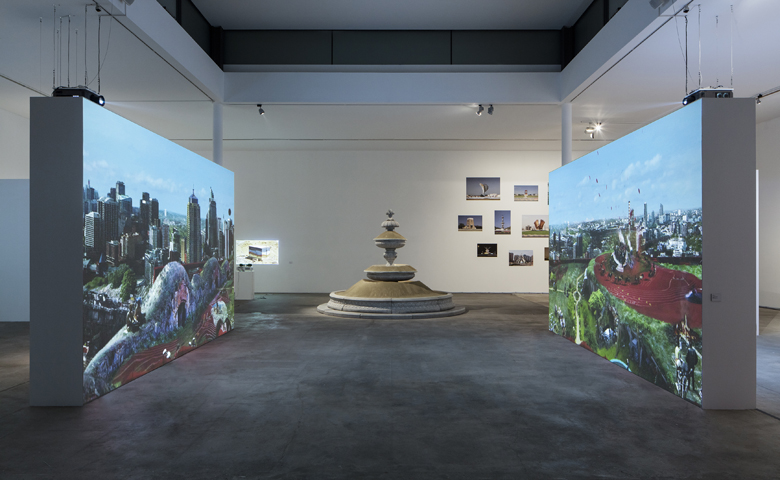

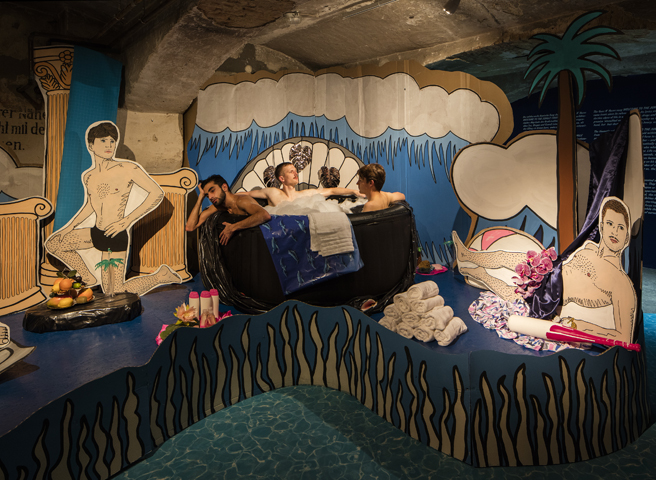

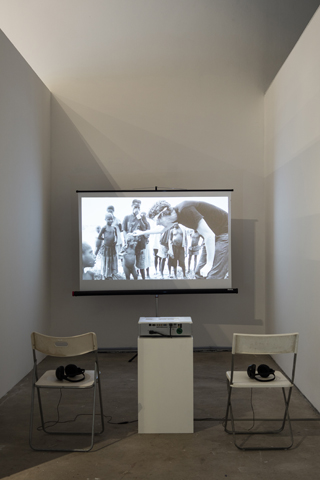

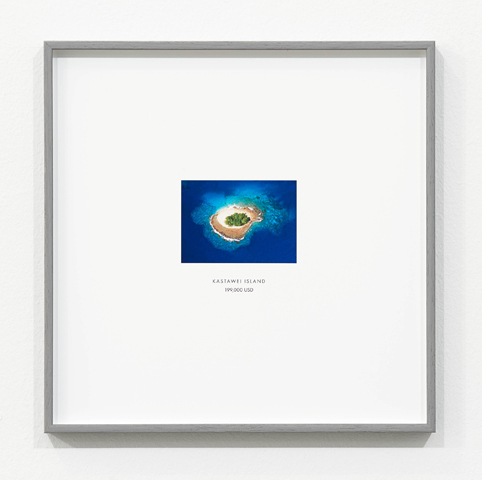

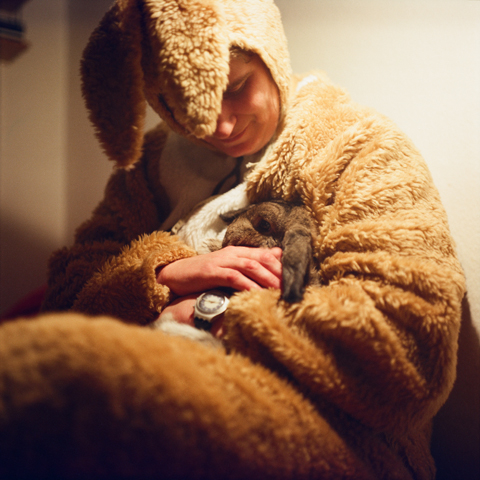
Comments